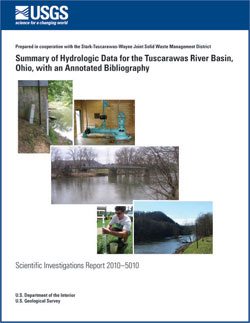 ABSTRACT
ABSTRACT
The Tuscarawas River Basin drains approximately 2,600 square miles in eastern Ohio and is home to 600,000 residents that rely on the water resources of the basin. This report summarizes the hydrologic conditions in the basin, describes over 400 publications related to the many factors that affect the groundwater and surface-water resources, and presents new water-quality information and a new water-level map designed to provide decisionmakers with information to assist in future data-collection efforts and land-use decisions.
The Tuscarawas River is 130 miles long, and the drainage basin includes four major tributary basins and seven man-made reservoirs designed primarily for flood control. The basin lies within two physiographic provinces—the Glaciated Appalachian Plateaus to the north and the unglaciated Allegheny Plateaus to the south. Topography, soil types, surficial geology, and the overall hydrology of the basin were strongly affected by glaciation, which covered the northern one-third of the basin over 10,000 years ago. Within the glaciated region, unconsolidated glacial deposits, which are predominantly clay-rich till, overlie gently sloping Pennsylvanian-age sandstone, limestone, coal, and shale bedrock. Stream valleys throughout the basin are filled with sands and gravels derived from glacial outwash and alluvial processes. The southern two-thirds of the basin is characterized by similar bedrock units; however, till is absent and topographic relief is greater. The primary aquifers are sand- and gravel-filled valleys and sandstone bedrock. These sands and gravels are part of a complex system of aquifers that may exceed 400 feet in thickness and fill glacially incised valleys. Sand and gravel aquifers in this basin are capable of supporting sustained well yields exceeding 1,000 gallons per minute. Underlying sandstones within 300 feet of the surface also provide substantial quantities of water, with typical well yields of up to 100 gallons per minute. Although hydraulic connection between the sandstone bedrock and the sands and gravels in valleys is likely, it has not been assessed in the Tuscarawas River Basin.
In 2001, the major land uses in the basin were approximately 40 percent forested, 39 percent agricultural, and 17 percent urban/residential. Between 1992 and 2001, forested land use decreased by 2 percent with correspondingly small increases in agricultural and urban land uses, but from 1980 to 2005, the 13-county area that encompasses the basin experienced a 7.1-percent increase in population. Higher population density and percentages of urban land use were typical of the northern, headwaters parts of the basin in and around the cities of Akron, Canton, and New Philadelphia; the southern area was rural.
The basin receives approximately 38 inches of precipitation per year that exits the basin through evapotranspiration, streamflow, and groundwater withdrawals. Recharge to groundwater is estimated to range from 6 to 10 inches per year across the basin. In 2000, approximately 89 percent of the 116 million gallons per day of water used in the basin came from groundwater sources, whereas 11 percent came from surface-water sources. To examine directions of groundwater flow in the basin, a new dataset of water-level contours was developed by the Ohio Department of Natural Resources. The contours were compiled on a map that shows that groundwater flows from the uplands towards the valleys and that the water-level surface mimics surface topography; however, there are areas where data were too sparse to adequately map the water-level surface. Additionally, little is known about deep groundwater that may be flowing into the basin from outside the basin and groundwater interactions with surface-water bodies.
Many previous reports as well as new data collected as part of this study show that water quality in the streams and aquifers in the Tuscarawas River Basin has been degraded by urban, suburban, and rural agricultural activity, discharges from municipal and industrial wastewater treatment and thermoelectric power plants, mining, and disposal of solid and hazardous wastes. Environmental effects from mining coal during the 1800s through the mid- to late-1900s continue to affect water quality and aquatic habitat in the basin.
As part of this study, seven groundwater samples and two surface-water samples were collected and analyzed for a wide variety of constituents. Several samples exceeded the U.S. Environmental Protection Agency Secondary Maximum Contaminant Levels for pH, iron, manganese, sulfate, and (or) residue on evaporation. Most of the analyses for pesticides, volatile organic compounds, and fecal indicator bacteria resulted in concentrations at or below detection limits; however, surface-water samples typically had more detections of these constituents than did groundwater. Wastewater compounds derived from urban wastewater discharges (including septic systems) were detected in only one of seven groundwater samples. Fecal coliform bacteria and E. Coli were detected in this same groundwater sample, indicating that this sample may have been affected by a nearby septic system. Analysis of age-dating tracers in the seven groundwater samples, including chlorofluorocarbons, tritium/helium, and sulfur hexafluoride, indicated that the average residence time of shallow groundwater was less than 50 years, confirming that shallow groundwater is relatively young and its quality is susceptible to contamination from current land-use practices. Tritium/helium and sulfur hexafluoride offer the best age-dating tools in this setting because the data indicate that chlorofluorocarbons were likely degraded under anoxic conditions.
As of 2009, a multitude of weather stations, 17 streamgages, 6 water-quality monitors, and 27 observation wells that monitor local hydrologic conditions were operating in and around the basin. Substantial historical water-quality data from surface-water and groundwater sites that were sampled on rotating schedules by other agencies provide a basis for analyzing trends in water quality. The data are consistent with the results of water-quality analyses obtained in this study; however, monitoring data collected during extreme events such as floods and droughts are lacking. To support future land-use decisions and document the influences of land-use change (which might include, for example, zoning, stormwater best management practices, and mine reclamation), additional continuously collected data would be needed to understand short- and long-term temporal changes in water quality.